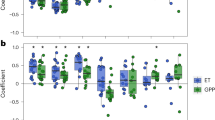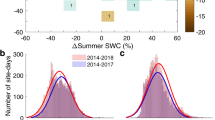Abstract
The relative contributions of dewfall (a flux of water vapour from air to surface) and distillation (a flux of water vapour from soil to canopy) to dew formation on closed canopy and bare soil surfaces are assessed, and the dependence of dew amount upon wind speed, absolute temperature, atmospheric stability, relative humidity, soil characteristics and cloudiness, all of which are significant factors, is evaluated. Some of these evaluations provide refinements to similar ones given in Monteith (1961). High dewfall rates are usually ≲0.06 mm hr−1 over canopy or bare soil, though upon a canopy under soil-saturated and air-saturated conditions, rates of dew formation may reach 0.07–0.09 mm hr−1 with contributions from distillation. Various sets of observations are reanalyzed to illustrate the importance of the horizontal advection of moisture in the nocturnal boundary layer (NBL) to observed high rates of dew formation arising from the atmospheric contribution of water vapour (dewfall). These locally observed high dewfall rates must be the result of small-scale or mesoscale horizontal advection of moisture in the NBL, since the humidity changes within the typically shallow NBL required to balance the loss of water at the surface are not observed. Over extensive areas of uniform surface (horizontal scales ≫10 km), such continuously high dewfall rates could only be balanced by a local supply of atmospheric moisture since advection of moisture would necessarily be small.
Similar content being viewed by others
References
Baier, W.: 1986, ‘Studies on Dew Formation Under Semi-Arid Conditions’,Agric. Meteorol. 3, 103–112.
Blackadar, A. K.: 1978, ‘High-Resolution Models of the Planetary Boundary Layer’, in J. Pfafflin and E. Ziegler (eds.),Advances in Environmental Science and Engineering, 1 Gordon and Breach, New York, pp. 50–85.
Burrage, S. W.: 1972, ‘Dew on Wheat’,Agric. Meteorol. 10, 3–12.
Camillo, P. J., Gurney, R. J., and Schmugge, T. J.: 1983, ‘A Soil and Atmospheric Boundary-Layer Model for Evapotranspiration and Soil Moisture Studies’,Water Resources Res. 19, 371–380.
Campbell, G. S.: 1974, ‘A Simple Method for Determining Unsaturated Conductivity from Moisture Retention Data’,Soil Science 117, 311–314.
Clapp, R. and Hornberger, G.: 1978, ‘Empirical Equations for Some Soil Hydraulic Properties’,Water Resources Res. 14, 601–604.
Clarke, R. H., Dyer, A. J., Brook, R. R., Reid, D. G., and Troup, A. J.: 1971, ‘The Wangara Experiment: Boundary Layer Data’, CSIRO, Div. of Met. Physics Tech. Paper No. 19, Melbourne, Australia, 352 pp.
Clarke, R. H. and Brook, R. R.: 1979, ‘The Koorin Experiment — Atmospheric Boundary Layer Data over Tropical Savannah Land’, Dept. of Science, Canberra, Australia, 96 pp.
Duvdevani, S.: 1953, ‘Dew Gradients in Relation to Climate, Soil and Topography’,Proceedings of the International Symposium on Desert Research, Research Council of Israel, Special Publ. No. 2, 136–148.
Fritschen, L. J.: 1982, ‘The Vertical Fluxes of Heat and Moisture at Vegetated Land Surface’, in P. S. Eagleson (ed.),Land Surface Processes in Atmospheric General Circulation Models, Cambridge University Press, Cambridge, pp. 169–226.
Fritschen, L. J. and Doraiswany, P.: 1973, ‘Dew: An Addition to the Hydrologic Balance of Doublas Fir’,Water Resources Res. 9, 891–894.
Garratt, J. R.: 1982, ‘Observations in the Nocturnal Boundary Layer’,Boundary-Layer Meteorol. 22, 21–48.
Garratt, J. R. and Francey, R. J.: 1978, ‘Bulk Characteristics of Heat Transfer in the Unstable, Baroclinic Atmospheric Boundary Layer’,Boundary-Layer Meteorol. 15, 399–421.
Garratt, J. R., Francey, R. J., McIlroy, I. C., Dyer, A. J., Helmond, I., Bradley, E. F., and Denmead, O. T.: 1979, ‘The International Turbulence Comparison Experiment (Australia, 1976) — Micrometeorological Support Data’, CSIRO Division of Atmospheric Physics Tech. Paper No. 37, Melbourne, Australia, 23 pp.
Geiger, R.: 1966,The Climate near the Ground, Harvard University Press, Cambridge, Massachusetts, 611 pp.
Hicks, B. B.: 1976, ‘Wind Profile Relationships from the “Wangara” Experiment’,Quart. J. Roy. Meteorol. Soc. 62, 535–551.
Hicks, B. B.: 1983, ‘A Study of Dewfall in an Arid Region: An Analysis of Wangara Data’,Quart. J. Roy. Meteorol. Soc. 109, 900–904.
Lettau, H. H. and Davidson, B.: 1953, ‘Exploring the Atmosphere's First Mile’, Vol. II, Pergamon Press, New York, pp. 377–578.
Long, I. F.: 1958, ‘Some Observations on Dew’,Meteorol. Mag.,87, 161–168.
Monteith, J. L.: 1957, ‘Dew’,Quart. J. Roy. Meteorol. Soc. 83, 322–341.
Monteith, J. L.: 1961, ‘Dew-Facts and Fallacies’, in A. J. Rutter (ed.),The Water Relations of Plants Basil Blackwell, London, 394 pp.
Monteith, J. L.: 1981, ‘Evaporation and Surface Temperature’,Quart. J. Roy. Meteorol. Soc. 107, 1–27.
Nakano, Y., Chao, T., and Hillel, D.: 1983, ‘Effect of Transient Partial-Area Shading on Evaporation from a Bare Soil’,Soil Science 135, 282–295.
Neumann, J.: 1956, ‘Estimating the Amount of Dewfall’,Arch. Meteorol. Geophys. Bioklim., Ser. A,9, 197–203.
Paltridge, G. W. and Platt, C. M. R.: 1976,Radiative Processes in Meteorology and Climatology, Elsevier, New York, 318 pp.
Philip, J.: 1957, Evaporation, and Moisture and Heat Fields in the Soil,J. Meteorol. 14, 354–366.
Priestley, C. H. B.: 1959,Turbulent Transfer in the Lower Atmosphere, The University of Chicago Press, Illinois, 130 pp.
Raman, C. R. V., Venkataraman, S., and Krishnaworthy, V.: 1973, ‘Dew over India and its Contribution to Winter-crop water balance’,Agric. Meteorol. 11, 17–35.
Shaia, J. S.: 1975, ‘The Humidity in the Eastern Mediterranean’, Series A (Meteorological Notes) No. 32, Israel Met. Service, Bet-Dagan, 25 pp.
Sharma, M. L.: 1976, ‘Contribution of Dew in the Hydrologic Balance of a Semi-Arid Grassland’,Agric. Meteorol. 17, 321–331.
Stephens, G. L., Campbell, G. G., and Vonder Haar, T. H.: 1981, ‘Earth Radiation Budgets’J. Geophys. Res. 86, 9739–9760.
Swinbank, W. C.: 1963, ‘Long-Wave Radiation from Clear Skies’,Q. J. Roy. Meteorol. Soc. 89, 339–348.
Tuller, S. E. and Chilton, R.: 1973, ‘The Role of Dew in the Seasonal Moisture Balance of a Summer-Dry Climate’,Agric. Meteorol. 11, 135–142.
Wallin, J. R.: 1967, ‘Agrometeorological Aspects of Dew’,Agric. Meteorol. 4, 85–102.
Webb, E. K.: 1975, ‘Evaporation from Catchments, in ‘Prediction in Catchment Hydrology',’Aust. Acad. Science 203–236.
Zangvil, A. and Druian, P.: 1980, ‘Measurements of Dew at a Desert Site in Southern Israel’,Geographical Res. Forum 2, 26–34.
Zilitinkevitch, S. S.: 1972, ‘On the Determination of the Height of the Ekman Boundary Layer’,Boundary-Layer Meteorol. 3, 141–145.
Author information
Authors and Affiliations
Rights and permissions
About this article
Cite this article
Garratt, J.R., Segal, M. On the contribution of atmospheric moisture to dew formation. Boundary-Layer Meteorol 45, 209–236 (1988). https://doi.org/10.1007/BF01066671
Received:
Issue Date:
DOI: https://doi.org/10.1007/BF01066671




